Short Haul Surprise

On the apron at Lusaka, Zambia.
December 4, 2019
All photos by the author
WHEN IS economy class better than business class? Never, basically. The distinctions, though, can sometimes be blurry, particularly on shorter flights. Which brings us to a pair of intra-Africa hops I took recently with South African Airways.
Logistically the flights were similar. Both were international but brief sectors, at about 90 minutes each. The first was aboard a widebody Airbus A330; the second on a much smaller, single-aisle A319. Now, any flight review comes with a critical disclaimer: experiences can very tremendously from one flight to the next. A terrible flight on Tuesday could be a wonderful flight on Wednesday, depending on everything from who’s sitting beside you to the temperament of your particular crew. Duly noted, but would you believe that coach on an A319 could be a better experience, and certainly a better value, than business on an A330?
Indeed it could, and here’s how:
Business class, Johannesburg (JNB) to Victoria falls, Zimbabwe (VFA). Airbus A330-300.
Like any premium class experience, this one started in the lounge. South African has two lounges in the international wing at JoBurg’s O.R. Tambo International Airport, named “Platinum” and “Premium.” The former is reserved for high-level frequent flyers, so for us it was the latter. Walking past the smoked-glass entry to the Platinum room, not to mention the luxe facade of the Emirates lounge just down the hall, it was easy to feel envious. But the Premium lounge was a more than comfy respite after the hectic immigration and security lines. It’s a bright, amply appointed space with plenty of seats and a sweeping view of the apron. This was a morning departure, and the buffet had all the breakfast fare you’d expect, both hot and cold. And maybe the best surprise of all, there were no shrieking kids or other obnoxious patrons.
Boarding, on the other hand, was noisy and chaotic, as it always is, with people ignoring the zone calls and crowding around the doorway and podium. (Something desperately needs to be done, industry-wide, about the boarding crush.) A placard indicated a priority lane for business class, but getting there meant pushing our way through a scrum of heedless passengers. When we finally stepped into the plane, the sudden peace and quiet was palpable.
The business cabin had 46 sleeper pods in a 1-2-1 configuration. This is South African’s top-of-the-line product. Not even its A340s, used on its longest intercontinental routes, have these seats, using a much tighter six-abreast layout instead. I was struck by the colors: sandy tones accented with red and silver. It was one of the more attractive cabins I’ve seen in some time, and the feel was warm and inviting. A shoulder panel featured all the usual mod cons: AC and USB ports, a reading lamp, seat controls, and a storage nook.
There was no amenities kit of any kind, though, and the headset compartment was empty. And the lack of a headset rendered my 15-inch video screen all but useless. Granted, this was a long-haul aircraft filling the gap on a quick morning turn between runs to Accra, Lagos or wherever, and we weren’t gonna get all the frills. That’s to be expected, and a missing amenities bag and headset aren’t much of a penalty on a flight so short. Nonetheless, it seemed a little… skimpy. I settled in, looking forward, at least, to a glass of champagne.

Seat 5A on the A330.
Except, there wasn’t any. Indeed, this goes down as the first time I’ve ever sat in business class and was not offered any type of pre-departure beverage. No champagne, no juice, nothing. Quite peculiar.
After takeoff I switched on my screen. The remote control device was cumbersome to manipulate, but after a few minutes of fumbling I managed to pull up the moving map display, tracking our progress as we crossed from South Africa into Botswana, taking in a sunny view of the Limpopo River and Botswana’s Makgadikgadi salt pan, where I visited some years ago.
A short while later a breakfast was served. Or snack, maybe, is the appropriate word. There was no printed menu, so I’m unsure what the airline called this particular entree, but imagine a cold, saucer-sized plate of sliced tomato, pepper, mushroom and cheese. It sounds better than it was. Julia had gone for the vegetarian option, which was far worse. In fact, it may have been the worst meal I’ve ever seen served on a plane: a plastic box of cast-off fruits and veggies featuring a deflated tomato, carrot shavings, a dehydrated pickle and lemon slices.
And the strangeness of the lack of a pre-departure drink was outdone only by a lack of wine once aloft. Drink options were restricted to coffee, juice, and soda. Again, very unusual. There was no hot towel service, either.
By the time we touched down at Vic Falls, I was bored and eager to disembark. This is not my usual feeling when traveling in premium class. If an airline is doing it right, you don’t want to get off. With a flying time of an hour-and-a-half, I didn’t expect the same service I’d get on a transoceanic flight. Still, this was a widebody plane on an international sector, however short, and the global standard — at least on legacy carriers outside the United States — is a higher one. It was a perfectly relaxing flight, but underwhelming just the same, especially at a price that was double the economy fare.

You call this business class?
Economy class, Lusaka, Zambia (LUN) to Johannesburg (JNB). Airbus A319.
Imagine my surprise, then, when the second leg, from the Zambian capital of Lusaka back to JoBurg, turned out to be more enjoyable. In economy class, no less, on a much smaller plane. Had the seat next to me not been empty, or had the flight been longer, the take-away might not be as positive. But the seat was empty, and it was a short flight — a surprisingly pleasant one that managed to throw the shortcomings of the first one into starker relief.
There were no jet bridges at LUN, and the aircraft was parked a good distance from the gate. While it might seem a silly thing, I appreciated the chance to walk to the jet, by way of a marked pathway that ran along the inside of the apron, rather than be forced into a jam-packed bus, which is usually how it works with remote parking. And I always thrill at the chance to board via old-timey air-stairs rather than through a window-less tube. I fully understand the negatives of stairs, but here’s something dramatic about stepping onto a plane that way: the ground-level approach along the tarmac followed by the slow ascent. The effect is like the opening credits of a film.
My big gripe was the hideously long check-in queue and disorganized boarding lounge, which probably had more to do with poor design than any failure on SAA’s part (a new, Chinese-built terminal is opening at LUN soon). I’ll also dock some points for the absence of any seat-back video on the A319. On the plus side, however, the 32-inch pitch felt unusually generous, cabin staff were extra-friendly, and the meal — a hot chicken and pasta dish — was five times better than the weird little pile of tomatoes and peppers I’d picked at on the way to Vic Falls.
And what’s this, complimentary wine! That Victoria Falls is predominately a leisure market might explain some of what happened on the A330, but let me get this straight: we were served complimentary wine in economy class, yet not in business, on what were otherwise identical routes? Talk about a head-scratcher.
For the price ($180), I got what I paid for and a little bit more. And isn’t that what it’s all about: expectation? This cannot be said for the first leg. Pretty much everything was better on the economy class ride, save for the seat itself. The business class pod was stylish and comfortable, but impossible to properly savor on a flight so brief. For twice the fare, it simply wasn’t worth it.

Economy meal, LUN to JNB.
Maybe SAA’s financial troubles have something to do with this? The carrier has been in distress for some time, under pressure from the Gulf carriers and fast-growing African juggernauts like Ethiopian Airlines and Kenya Airways. In December the carrier was placed under the provisions of “business rescue” — the South African equivalent of bankruptcy protection.
For now, SAA holds membership in what I call the Six Continent Club. That is, it’s among only a handful of airlines to serve at least one city on each of the major continents. (For SAA that means New York and Washington in North America, Hong Kong in Asia, Sao Paulo in South America and Perth in Australia.) Nevertheless, I was startled when I flipped open the inflight magazine and had a look at the destinations map. What used to be a respectable global network has been whittled away. The airline currently serves only three cities in Europe, and a high percentage of its flying — even across much of Africa — is handled by partner carriers.
South African Airways is one of the world’s “classic” legacy carriers. In the 1970s and 1980s, its 747s and 747SPs helped pioneer ultra long-haul flying. South Africa itself has a rich aviation history, and has trained thousands of pilots whom, faced with a dearth of jobs at home, have gone on to work for airlines elsewhere around the world. Surely the country deserves an airline to call its own.
South African’s radio call sign is “Springbok” — one of the coolest and most evocative call-signs out there. For that reason alone I hope they make it.
This article appeared originally on The Points Guy website and is being used with permission.
For photos from Zambia, visit the author’s Instagram stream.
Related Story:
LONG LIVE AIR MALTA
A Gourmet Diversion. Savory Snapshots From 30,000 Feet.
March 20, 2023
HERE ARE some pictures of airline food. Pardon such a vapid diversion, but most aviation news these days is depressing. Plus, I’m hungry.
Before the coronavirus madness began, we’d reached a point where the food in international premium class could rival that of a fancy restaurant. Carriers took pride in their onboard product: the food itself, the presentation, choreography — the whole indulgent kabuki of premium class, from the menus to each carrier’s signature cutlery. It could be pretentious, but always fun.
The pandemic wiped that out, but things have slowly bounced back. An airplane ride no longer feels like a medical evacuation and flight attendants have stopped dressing like the firemen at Chernobyl.
Here, in no special order, are some examples. New and old, fancy and not so fancy. I’ll be adding to the list as my photo archives cough up forgotten snapshots. And, hopefully, through future travels.
These weren’t employee freebies. I’ve spent a lot of money on these seats. Maybe let me flex a little…
Philippine Airlines
A business class meal aboard a Philippine Airlines A330, Singapore to Manila. Adequate if underwhelming. This was a three-hour, intra-Asia service; presumably the airline’s long-haul routes have a more lavish spread. Not visible are my second and third helpings of garlic bread. Yum.
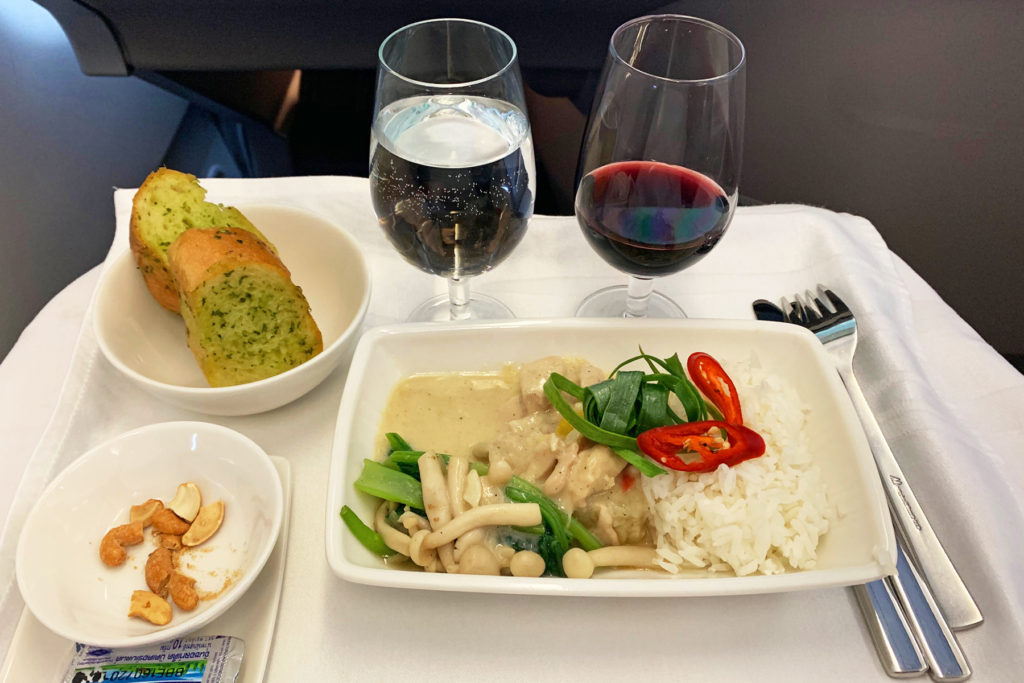
China Airlines
The upper photo shows a business class dinner en route from Taipei to Amsterdam. The cabin decor on this Airbus A350 was strikingly handsome, gold highlights and elegant wood tones. The food was less impressive, and they were super stingy with the wine. The lower pic showcase the carrier’s shorter-haul service on the A330.
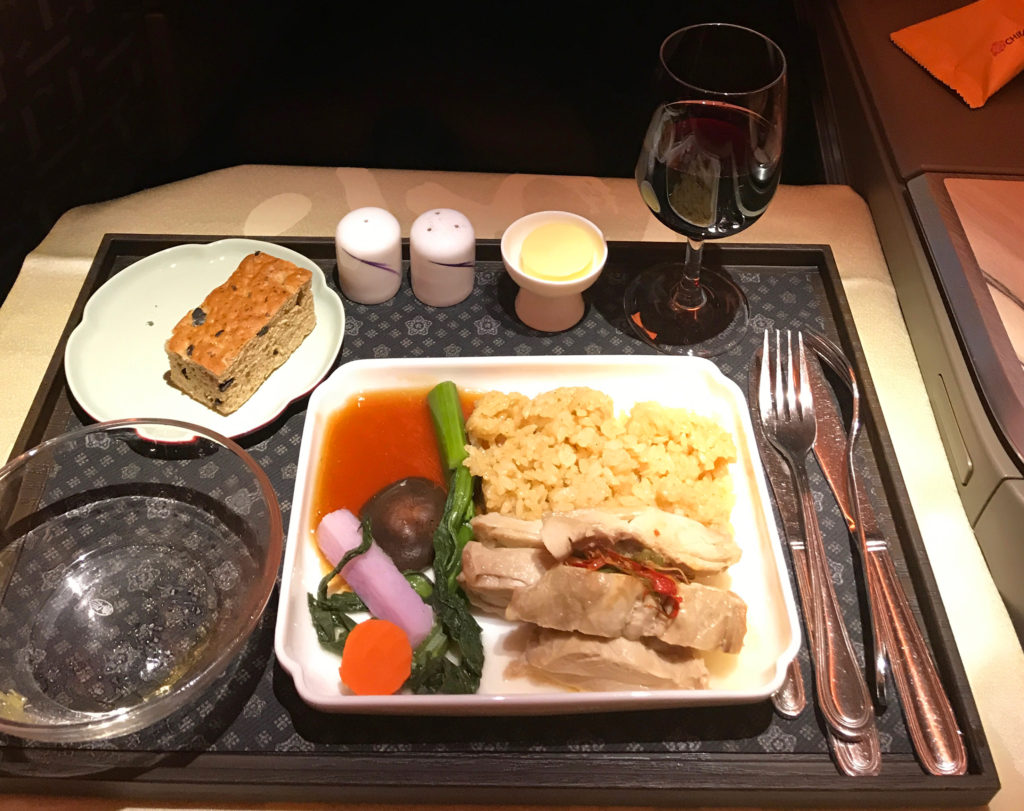


South African Airways
Economy class dinner on the quick hop from Lusaka, Zambia, to Johannesburg. The second pic beholds one of the sadder things I’ve seen on a plane. Believe it or not, this was the business class vegetarian entree, served on the Johannesburg-Victoria Falls route. Click here for a detailed review of this flight.


Qatar Airways
Qatar’s business class food is arguably the best in the world. What you see here is the short-haul version, served on a two-hour flight from Doha to Yerevan, Armenia. Keep scrolling for a peek at long-haul.


Sky Airline
Sky Airline (there is no “s”) is a Chilean carrier, and this was the economy meal on a 737 between Santiago and Punta Arenas. Let’s just say that I loved the paper tray liner, and leave it there. The green plastic silverware was a curious and, some would say, unappetizing touch.

Sri Lankan Airlines
A beautiful little menu to whet your appetite on the way from Bangkok to Colombo. The meal itself was standard economy fare. Maybe the best thing you can say about economy class food is to call it “uneventful,” and this was no exception. The seat-pocket magazine is called Seredib — a sanskrit term from which the word “seredepity” comes from.

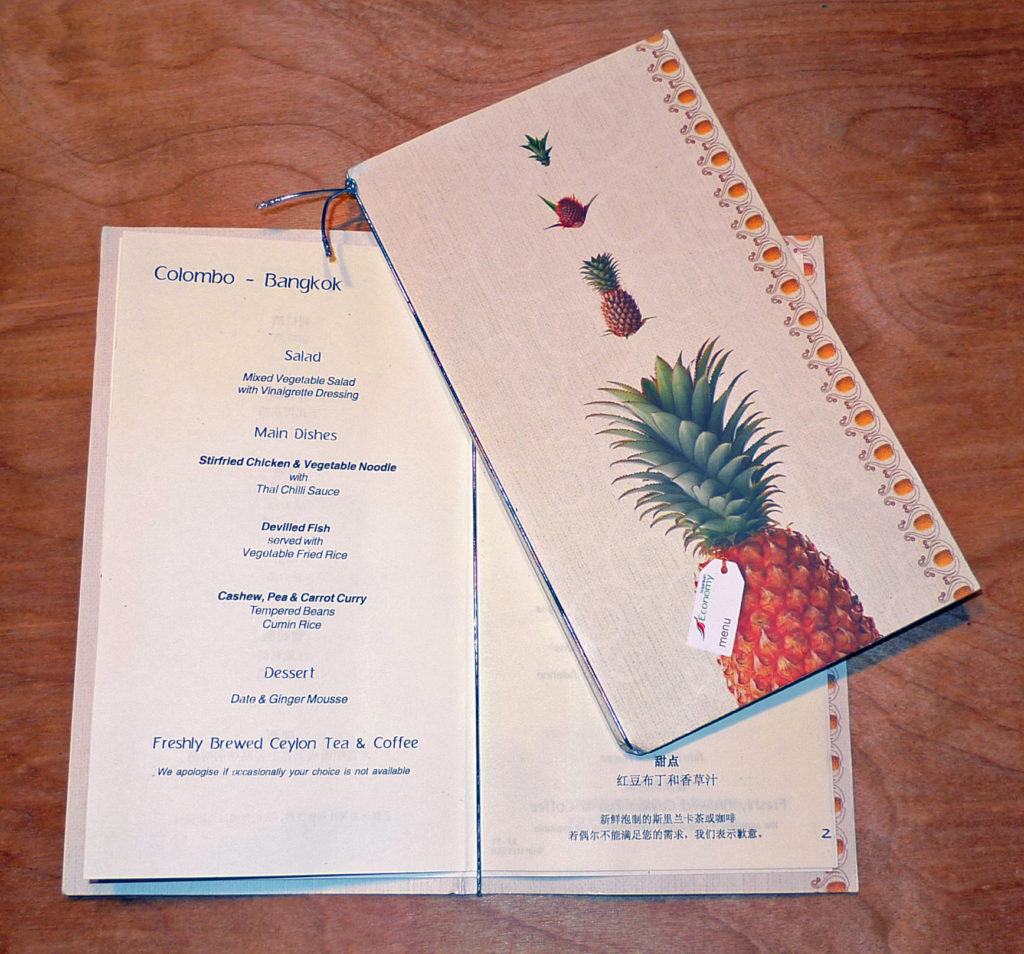
Drukair
One of Bhutan’s two airlines, Drukair flies smaller planes and offers a limited, if tasty business class menu. Here you see the lunch options on the daily run from Paro to Bangkok. This flight is further reviewed here.

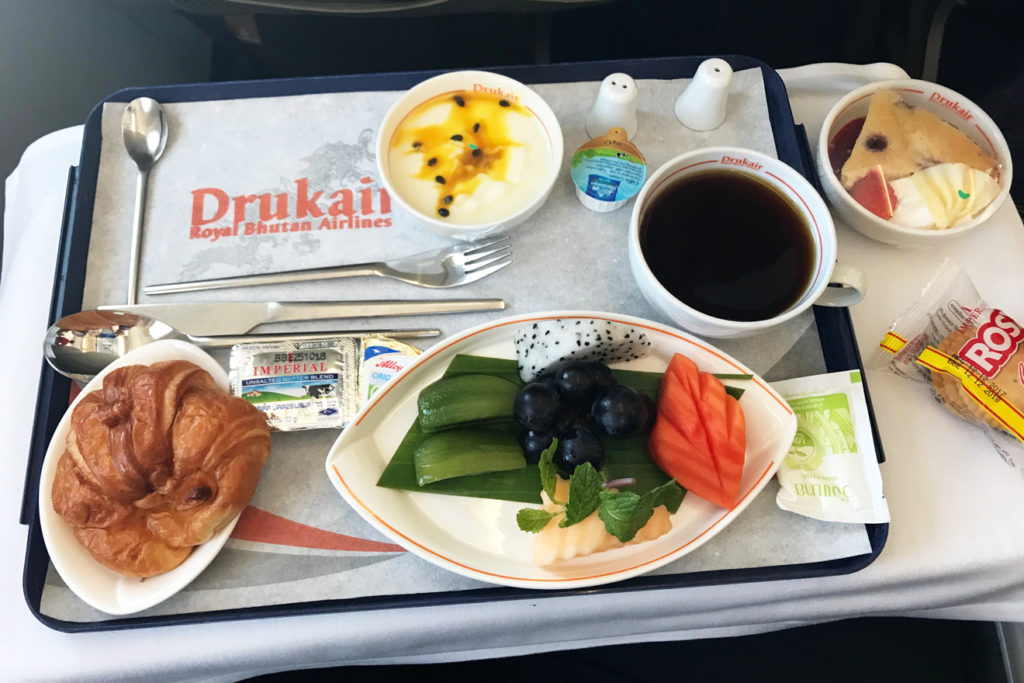
Qatar Airways
Here are the promised long-haul shots. Qatar’s business menu is on-demand, meaning you order whatever you want, whenever you want it. There’s no scripted service, per se, with trays and carts coming down the aisle. These are some of the appetizer or “lite bite” options — a delicious soup, a mezze platter, and a couple of mini-burgers — plus a wonderful dessert.



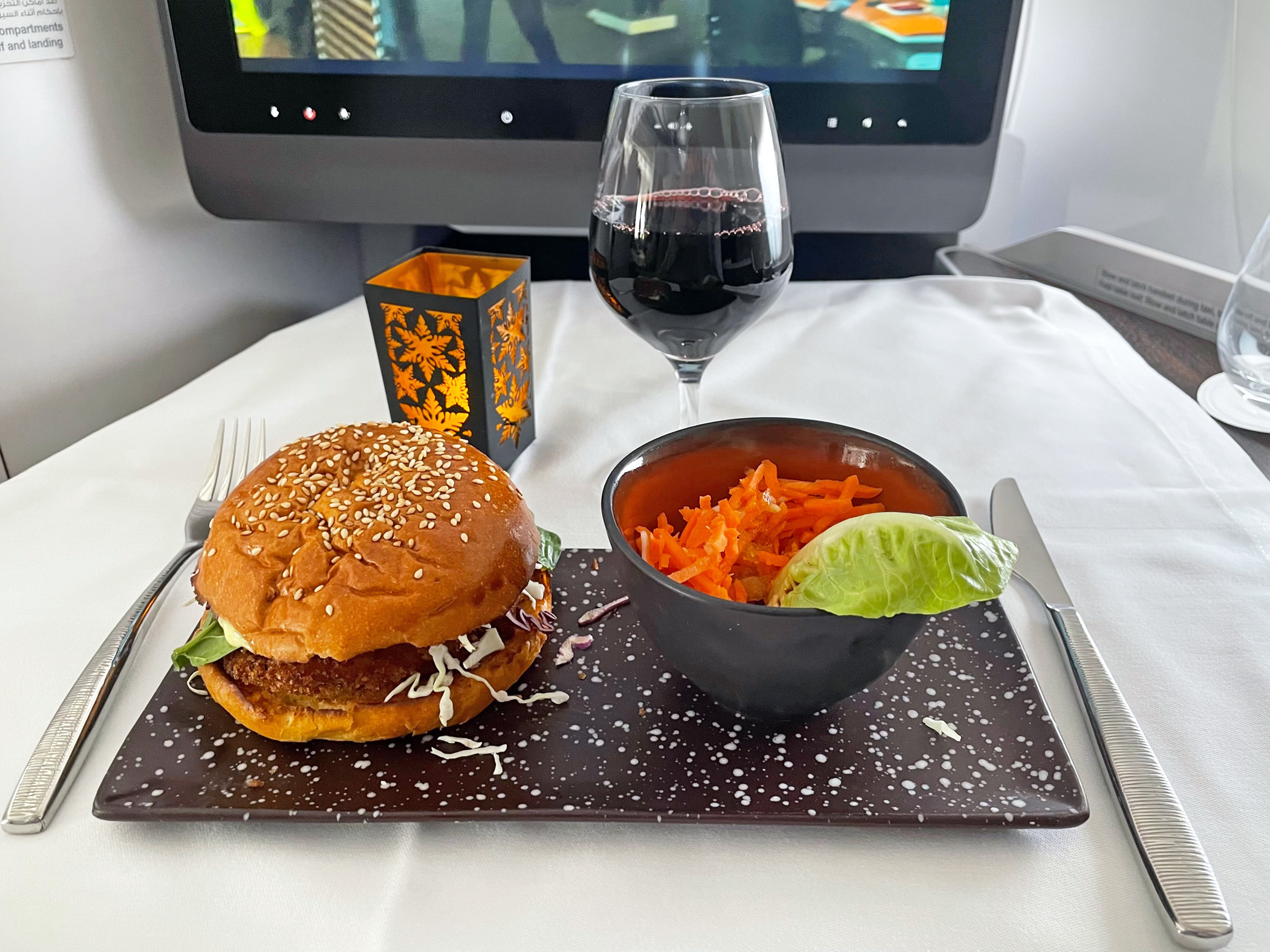

Korean Air
This was first class from Incheon to Bangkok in one of Korean’s inter-Asia 747s with an older configuration that is no longer used. Notice the pull-out style entertainment screen and non-sleeper seat. Talk about slumming it! And if that noodle concoction looks a little too sloppy and greasy, it was.


Singapore Airlines
For whatever reason, I failed to keep any photos of the business class delectables I enjoyed one night on the long ride from Singapore to Amsterdam. Instead I have this less interesting picture from a shorter flight. This is what you get on an A330 between Singapore and Japan.

Kenya Airways
Bangkok to Hong Kong with Kenya Airways. A decent lunch and a can of Tusker. What’s not to like? And although you can’t see it here, this airline provides the world’s most luxurious fleece blankets. The crew even let me abscond with one, and today it resides on my couch. What they didn’t have, at least on this vintage 767 (since retired), is an entertainment system. I spent several perplexed minutes trying to locate my screen before realizing there wasn’t one.

Thai Airways
On the red-eye from Bangkok to Incheon. Another satisfying if unspectacular economy dinner.

Air Malta
Like the aforementioned Drukair, Air Malta operates only narrow-body planes on shorter routes (pictured is Heathrow to Valetta), and they do what they can with limited time and space. This involves some improvising, such as folding down the center seat to create a kind of instant business class. The result, all things considered, is surprisingly pleasant. Read more about it here.
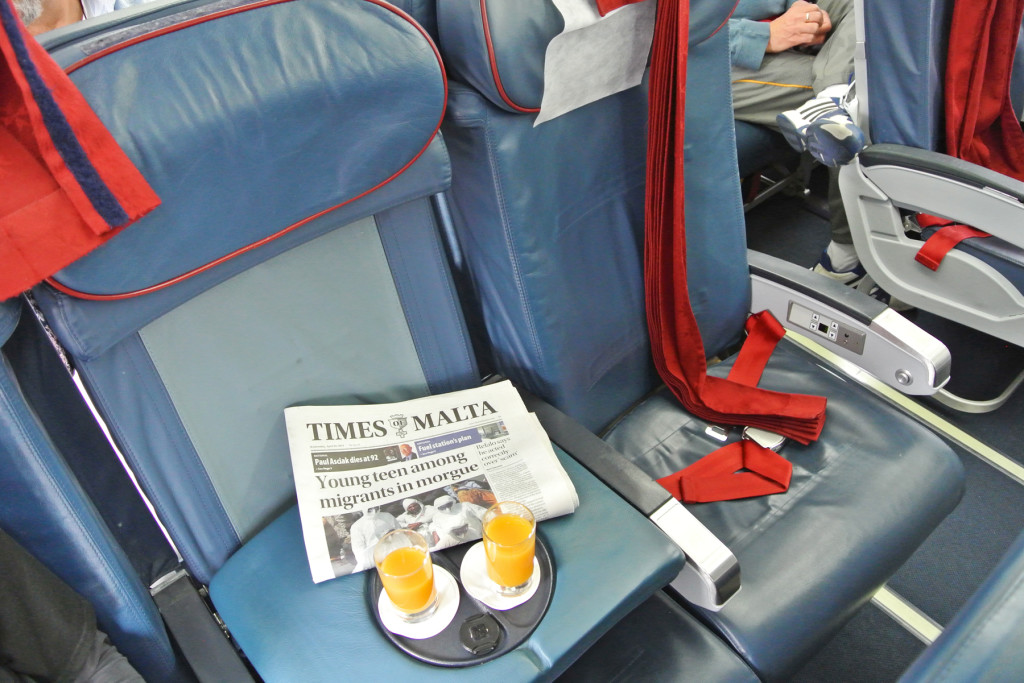

Emirates
Emirates first class is… well. You’re looking at flights to Mauritius, Johannesburg, and Phuket. Similar to Qatar Airways, this is dine-on-demand, and you’re free to mix and match entrees, appetizers, and desserts to your heart’s content. We start with a welcome-aboard glass of Dom Perigean; then we see a mezze appetizer spread (yes that’s an appetizer), a shockingly delicious chicken biryani, and a tuna dish. Flying out of Johannesburg, I was intrigued by the ostrich filet (see the menu photo), but the pesto ravioli was tempting too. My cabin attendant prepared both. All the while, there’s a snack basked on your console. Mind you this is first class; Emirates business is a lot less lavish.






Battle of the Bars
The Airbus A380s at Emirates and Qatar both have onboard lounges. Qatar’s is situated in the center of the upper-deck. The Emirates version is also upstairs, but in the back, behind business class. Emirates also has an exclusive upper-deck bar only for first class customers, located at the forward bulkhead between the shower spas. The lounge is staffed by a bartender, while the forward bar is serve-yourself.


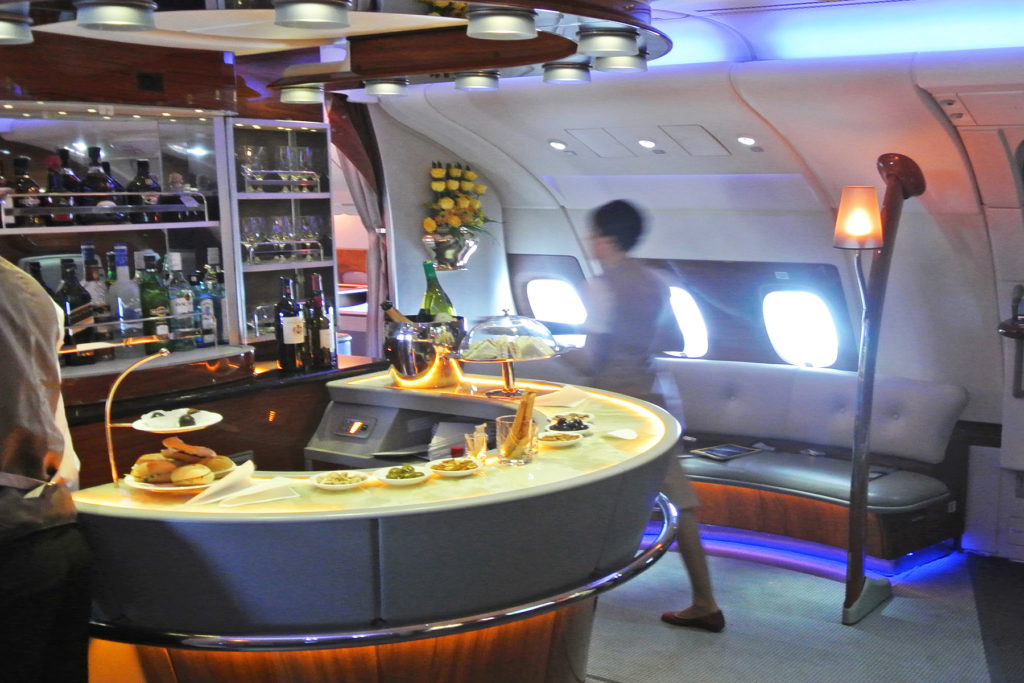

Tea Time
At the top, tea service on Qatar. On Emirates, the forward bar is taken down prior to arrival and a tea station is arranged in its place, backdropped by ornamental stones and waterfall. I mean, it’s hardly an airplane without rocks and a waterfall.
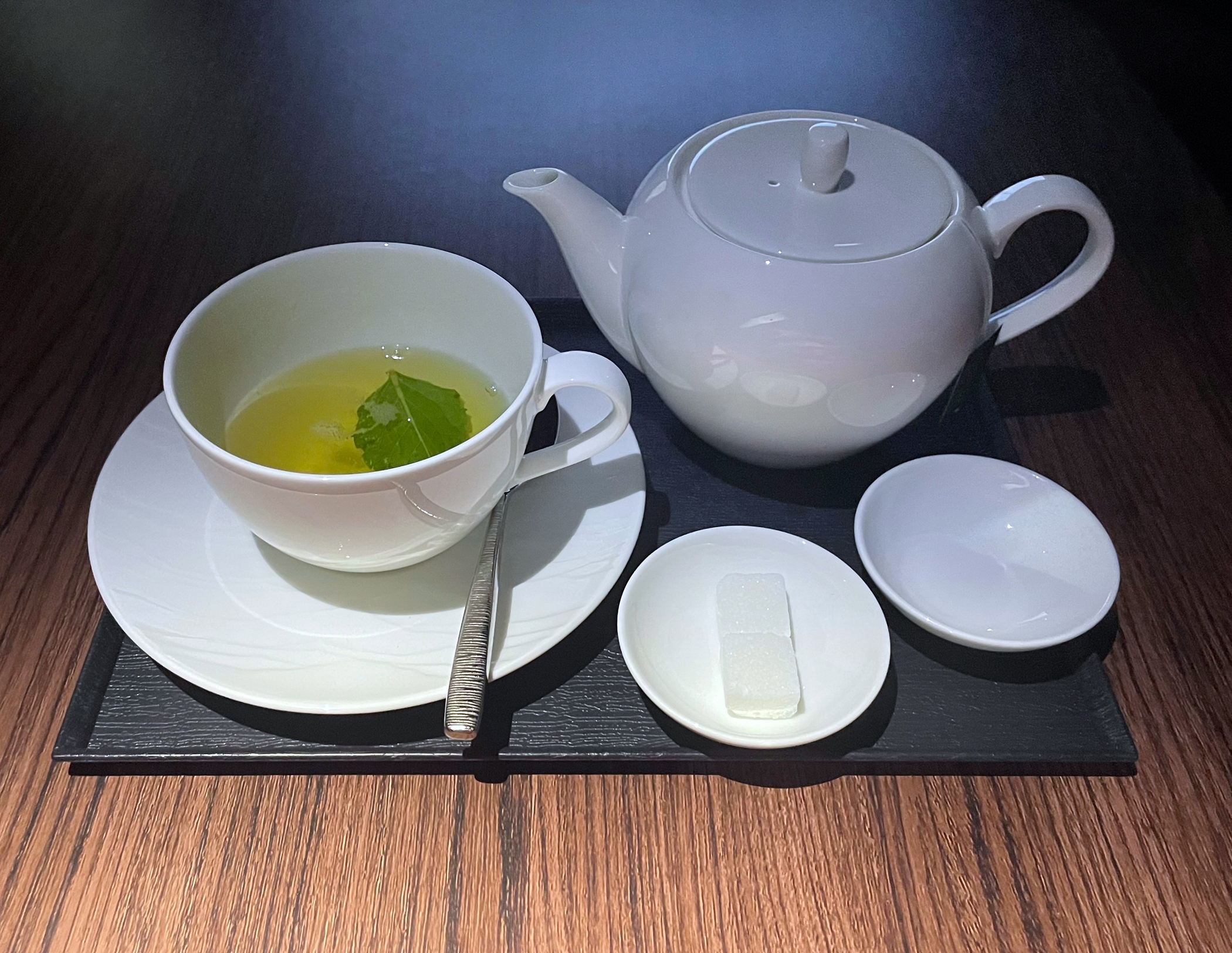
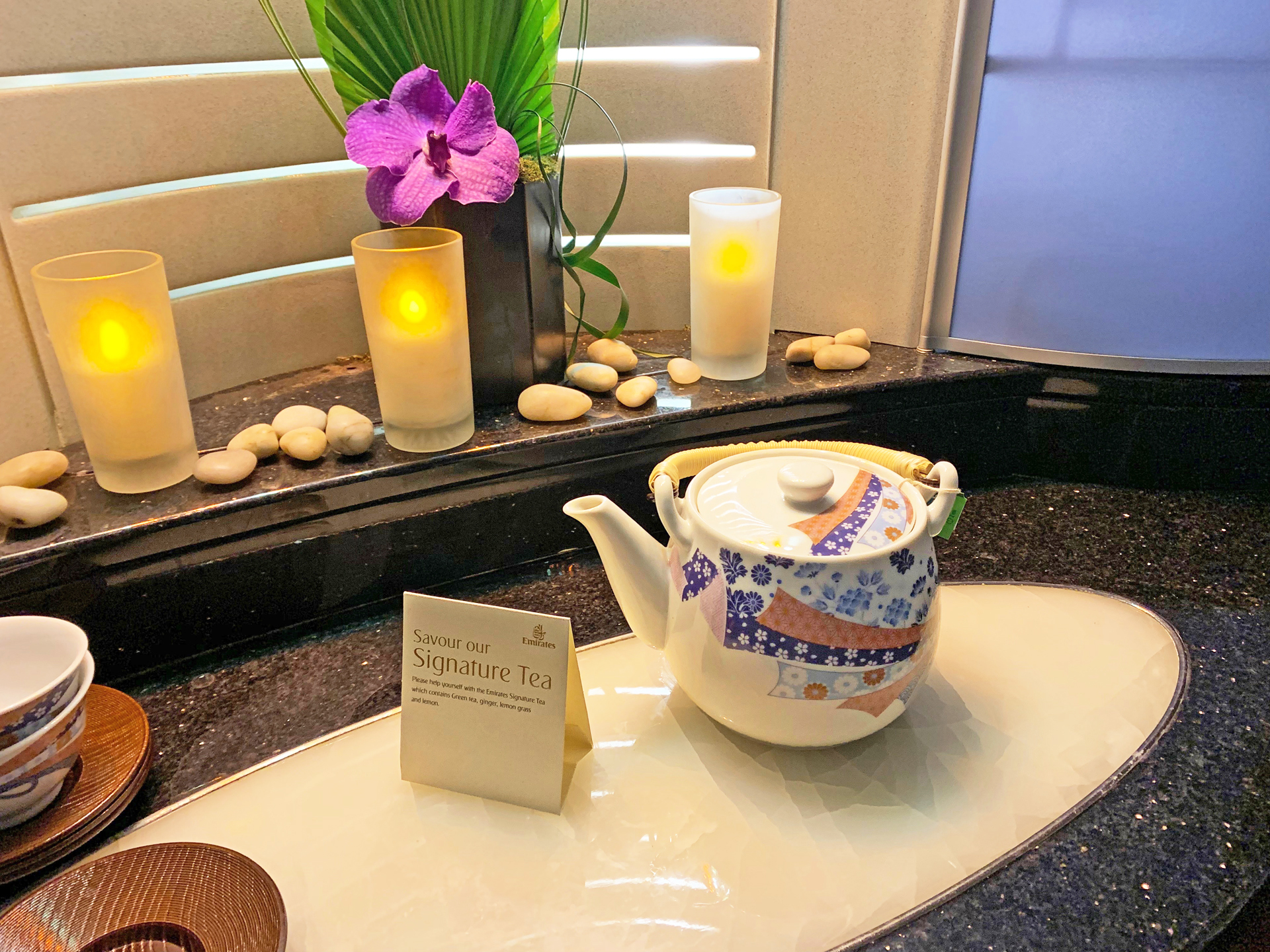

The Quiet Americans
Looking at those photos from the Gulf carriers, it’s easy to see that none of this is fair. Competing with heavily subsidized, government-owned airlines is pretty much impossible for American, European, and even most Asian carriers. Which isn’t to say their onboard products aren’t good. My photo collection doesn’t show it, but I’ve experienced most of them, and they hold their own. We’ve come a long way since the early 2000s, when broken seats, lousy food and terrible service were the standard.
Going back to 2019, before the COVID fiasco re-set the clock, the clear U.S. winner was Delta. Its international business class, now branded as Delta One, offered good food and an elegant, choreographed presentation with appetizer, soup, and dessert courses all delivered separately. It was a professional and gracious experience that United and American didn’t match even with bigger planes. Heck, it even blew Emirates’ business away. Delta also has the world’s best inflight entertainment system.
None of the U.S. carriers have returned quite to where they were pre-pandemic, but it’s not by accident that Delta keeps earning most of the passenger choice awards.




